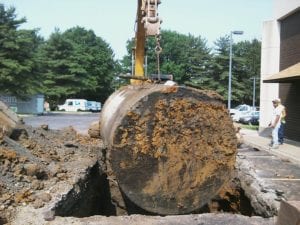How to sell a property with a UST
 Are you a property owner attempting to sell a commercial property with an underground storage tank (UST)? Do you know how to approach the selling process to avoid under-selling your property? Commercial real estate owners must be aware of the negative impact contamination from a leaking underground storage tank has on property value. Many prospective property owners may be unaware or afraid of the requirements for operating tanks or having them removed. USTs make properties less appealing to potential buyers because they are an environmental liability and an invitation for regulatory agency interference. However, a property with a properly maintained UST will be much more attractive to potential buyers. There is a reduced chance of regulatory agency interaction and a lesser risk of post-transaction issues. In this article, we will explain the process of selling property with an underground storage tank.
Are you a property owner attempting to sell a commercial property with an underground storage tank (UST)? Do you know how to approach the selling process to avoid under-selling your property? Commercial real estate owners must be aware of the negative impact contamination from a leaking underground storage tank has on property value. Many prospective property owners may be unaware or afraid of the requirements for operating tanks or having them removed. USTs make properties less appealing to potential buyers because they are an environmental liability and an invitation for regulatory agency interference. However, a property with a properly maintained UST will be much more attractive to potential buyers. There is a reduced chance of regulatory agency interaction and a lesser risk of post-transaction issues. In this article, we will explain the process of selling property with an underground storage tank.
Determine contents stored in the tank
State and federal environmental agencies regulate hazardous materials and petroleum products stored in USTs. There are some exceptions which may vary by state, including farm or residential tanks which are used for storing motor fuel for noncommercial purposes and tanks used for storing heating oil for consumptive use on the premises where stored. If your tank does not fall into these categories, it may be regulated; requiring certain compliance activities to demonstrate that your tank is in good shape.
Determine the size of the tank
Required compliance activities may also be dictated by the size of the tank. Requirements vary by state and commonly the tank is regulated unless it is considered a farm or residential tank with a capacity of 1,100 gallons or less which is used for storing motor fuel for noncommercial purposes. In addition, an underground storage tank system with a capacity of 110 gallons or less is not regulated. Regulated tanks usually need to be removed by a certified UST contractor while any contractor may remove unregulated tanks.
Determine the material the tank is made of
Tanks are typically constructed of one of two types of material: steel or fiberglass. Steel tanks are usually older and can develop problems if they have not been maintained and monitored over the years. Fiberglass, both single-wall and double-wall, tanks are typical of what is currently being installed. These tanks do not rust over time and are more dependable.
Determine the age of the tank
As a general rule of thumb, the older a tank, the greater the potential for problems. Over time, tanks can degrade, such as a steel tank corroding/rusting and develop holes that can lead to a release. Older tanks may be subject to additional monitoring and testing requirements.
Determine if the tank needs to be tested and/or removed
If the tank is regulated, there should be some sort of testing taking place. If the tank is unregulated and the property is to be sold, testing the tank will determine if it is of solid integrity. Providing the buyer with passing test results may assuage any concerns regarding associated environmental liability. However, in many cases, it may be advisable to remove the tank to clearly demonstrate there are no issues.
Determine if the tank is accessible
Trees, buildings, and other structures may cause complications during the removal process. If any of these things are in close proximity, be wary of undermining them and causing structural instability.
Aside from an increased level of difficulty for removal, close proximity to buildings presents an opportunity for accumulation of explosive vapors and/or impact to indoor air quality. Most states have started to require air quality testing when contaminant plumes approach the vicinity of a building.
Determine if there has ever been a release
The release of product from a UST can contaminate surrounding soil, groundwater or surface waters, and indoor air spaces. Determining the type of product and the extent of the release will help to determine the level of contamination of on-site receptors. A release to the environment will trigger the potential for regulatory intervention and third-party liability expenses.
Determine location related to environmental receptors
Contamination of wells that supply potable water to the property or a network of users is never a good thing. Extraordinary cleanup measures must be taken to rapidly clean up the spill so that contamination is contained and does not have a chance to spread to sensitive receptors. In some cases, installation of a water treatment system is necessary. This can be a long-term, expensive, and highly visible process.
Determine UST location relative to underground utilities or surface water bodies
Close proximity to underground utilities presents an opportunity for accumulation of explosive vapors. In older areas of the country, there have been occasions where vapors from impacted sewers and storm drains have migrated into buildings and caused evacuations. Utilities also provide a conduit for contaminated groundwater, allowing it to travel much more quickly than it would through soil.
Determine state requirements for removing a tank
According to the state’s requirements, removal or abandonment of the tank occurs upon the collection of all necessary information. The process is as follows:
Notification
If removal or abandonment of the tank is necessary, the property owner may have to notify the state regulatory agency before taking any action. Many states and local jurisdictions have specific forms that must be filled.
Choosing a contractor
In most states it is a requirement to employ the services of a licensed contractor for the removal of a regulated tank. To ensure the best service, choose a contractor who has experience with tanks similar to the ones on the property. Some states will even provide a list of certified contractors.
Removal
A contractor empties the tank of its  contents, cleans, removes, and disposes of the tank and associated components such as piping, vent lines, remote fills, dispensers, etc. During the excavation and removal of these items, soil and groundwater, if encountered, need to be sampled from locations prescribed in the state’s UST closure guidance. These samples must be analyzed for specific compounds, which are dependent on the material stored in the tank. Sampling is required, even if contamination is not suspected.
contents, cleans, removes, and disposes of the tank and associated components such as piping, vent lines, remote fills, dispensers, etc. During the excavation and removal of these items, soil and groundwater, if encountered, need to be sampled from locations prescribed in the state’s UST closure guidance. These samples must be analyzed for specific compounds, which are dependent on the material stored in the tank. Sampling is required, even if contamination is not suspected.
Report
Each state has different requirements for underground storage tank closure reports. Generally, the removal activities discussed above are summarized, including disposal documentation of the UST system components, documentation of the soil disposal, a site plan illustrating the sampling locations, and the analytical information from soil and groundwater samples. This analytical summary will demonstrate whether there was any quantifiable impact to the subsurface and will aid in determining whether any further actions are warranted.
Tank registration
Tank registration must be amended to reflect all changes. State UST regulations usually require the submittal of some sort of Storage Tank Registration Amendment Form indicating the permanent closure of a tank.
A well-maintained, properly registered, and up-to-date UST can be an asset to a property, especially if it is necessary for heating or commercial processes. If it is not necessary, a properly documented tank removal eliminates the need for a Phase II Environmental Site Assessment and streamlines property sale.
Environmental regulations related to underground storage tank maintenance, closure, and property transactions can be confusing and complicated, and they vary slightly between each state. If you have any more questions about selling property with an underground storage tank, please contact us here.
To read more about underground storage tanks, check out the following articles:
The 7 Best UST Contractors in New York
The 8 Best UST Contractors in North Carolina
The 9 Best UST Contractors in Pennsylvania
Steps to Take After an Underground Storage Tank Release is Detected
What is My Financial Responsibility for Owning an Underground Storage Tank in North Carolina?
How Do I Make a Claim for Pennsylvania Leaking Underground Storage Tank Cleanup Costs?


